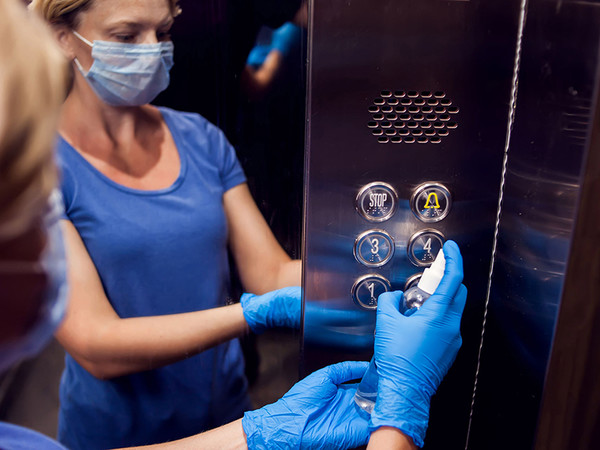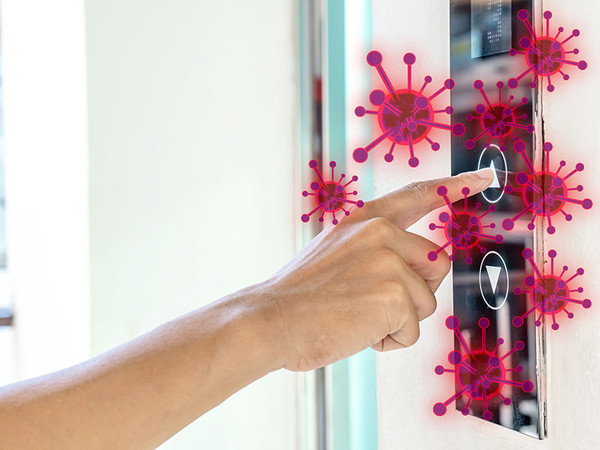Pro: Virus transmission in lifts?
Many companies from the lift sector have invested time, money and energy in systems to protect lift users from Corona infections. But how great is the risk and how can they best be mastered?
LIFTjournal lets two authors with different opinions and assessments express their views.
By Daniel Ehlers
Many people in a cramped space – using a lift these days is often accompanied by a feeling of unease. As a result of the pandemic, we have become much more attentive to hygiene: distancing, wearing masks, ventilating. In most cases, this works well – but what about in cramped spaces, such as lifts?
The fact that lifts can be a source of infections has today been clearly documented by various scientific studies. People have to stand close together in the usually small cars, while there is scarcely any exchange of air and usually poor ventilation. Viruses feel particularly at home here and are frequently found in the air. Bacteria are larger than viruses and cannot remain in the air for as long; consequently, they tend to find refuge on surfaces. However, opinions differ on how to approach this potential hazard.
Long-lived viruses
 Photo: © Aleksej Sarifulin/123RF.com
Photo: © Aleksej Sarifulin/123RF.comA study (1) by six laboratories and institutions in Spain indicated that lift buttons in facilities such as care homes, schools, kindergartens, youth accommodation, hospitals and social health centres were the places where viruses were most frequently found (in this study noroviruses).
What many do not know: flu viruses can survive on surfaces for two days, noro- and rhinoviruses for up to seven days and rotaviruses for even up to eight weeks. These are surpassed by the viruses that cause streptococci. They can survive for up to half-a-year (2).
One thing is certain: a sustainable hygiene concept should not only concentrate on Corona viruses. Every year, many fall sick and there are several hundred up to thousands of deaths from other infectious illnesses. Hence, disinfection of air and surfaces has to be considered for an effective and sustainable hygiene concept. If one compares the numbers of those dying from infectious illnesses with the 2,724 traffic deaths in 2020 in Germany, it is a wonder that this subject did not receive more intensive consideration earlier.
Disinfection solutions
Manual disinfection requires great personnel effort and as a result also high costs – in addition, only surfaces are disinfected here. Ventilation is 100 percent the contrary approach: longer opening of doors only helps to reduce the aerosol particle load. Nevertheless, the level is insufficient to speak of disinfection.
 Photo: © Kanokpol Prasankhamphaibun/123RF.com
Photo: © Kanokpol Prasankhamphaibun/123RF.comFurthermore, this procedure cannot be implemented in all lifts. Lifts with hinged wing doors or access points in outdoor areas (e.g. railway stations) as well as older lifts cannot employ this procedure – a modern door controller or individual improvised solution is required.
This also ignores the fact that many lifts are very busy at particular periods and as a result the doors cannot be kept open for long enough. The physicist and aerosol researcher Gerhard Scheuch has demonstrated this (3).
Overall, according to Scheuch, opening and closing the doors only has a very limited effect on reducing aerosol concentrations in the car. This only changes if there is a clear temperature difference inside and outside the lift, which is only exceptionally the case in hotels, hospitals or office buildings.
Alternative UV-C light
Effective and affordable innovations are called for to close this hygiene gap. Professional deployment of UV-C light has been a tried-and-tested means of disinfection has been a genuine alternative for decades.
This very quickly renders micro-organisms such as viruses, bacteria, yeast and fungi harmless and can no longer reproduce – on surfaces, in the air and even in water. Those who only consider contamination in the air are unfortunately overlooking half the situation.
The author is the CEO and co-founder of Uventions.
Contra: Virus transmission in lifts?
Sources: (1) https://www.journalofhospitalinfection.com/article/S0195-6701(20)30059-1/fulltext
(2) The tests were performed on dry, inanimate surfaces; Axel Kramer, Ingeborg Schwebke et al.: How long do nosocomial pathogens persist on inanimate surfaces? A systematic review: https://www.ncbi.nlm.nih.gov/pmc/articles/PMC1564025/
(3) https://www.focus.de/gesundheit/aerosol-messung-im-hochhaus-corona-falle-fahrstuhl-messung-zeigt-extremes-risiko_id_13249459.html


























Write a comment